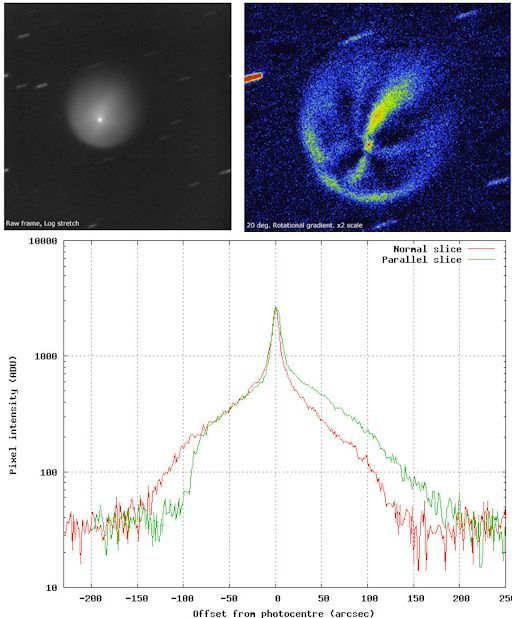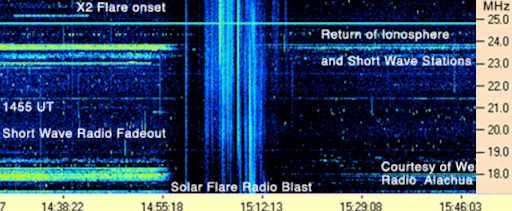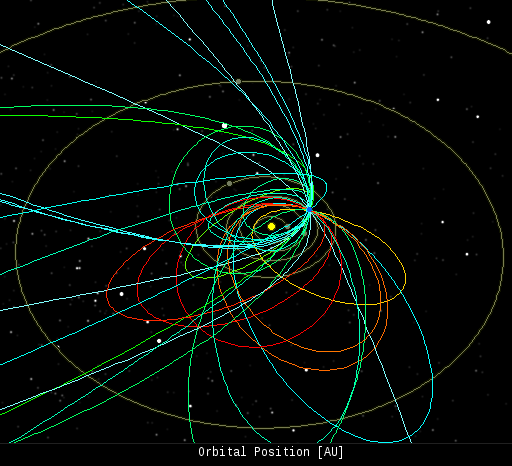When is the best time to see auroras? Where is the best place to go? And how do you photograph them? These questions and more are answered in a new book, Northern Lights - a Guide, by Pal Brekke & Fredrik Broms. | | |
WEAK IMPACT, MORE TO COME: A CME swept past Earth during the late hours of Oct. 26th, but its impact was weak and did not spark significant geomagnetic activity. Attention now shifts to Oct. 28th when the first of the CMEs from last week's X-flares is expected to deliver a glancing blow to Earth's magnetic field. NOAA forecasters estimate a 20% chance of polar geomagnetic storms. Aurora alerts: text, voice.
SPACE WEATHER RADIATION BALLOON: According to a recent NASA report, astronauts aren't the only ones who need to worry about solar storms. High-altitude air travelers can also be exposed to doses of solar radiation and cosmic rays. Even when the sun is quiet, a single trip from Chicago to Beijing can deliver the rad-equivalent of two chest x-rays. To explore the effects of space weather on aviation, on Oct. 27th the students of Earth to Sky Calculus used a helium balloon to send a pair of radiation sensors to the stratosphere. Here is a montage of launch photos from their "edge of space port" in the Sierras of central California:

At the time of this writing, the balloon is still in flight. It is equipped to measure alpha and beta particles as well as X-rays and gamma rays at altitudes as high as 120,000 feet. Within a few hours, the payload will parachute back to Earth. A recovery team will gather the sensors and begin analyzing the readings as early as Oct. 28th.
Another balloon flight could be in the offing. Active sunspots AR1875 and AR1877 are approaching the sun's western limb where they will become magnetically connected to Earth. Energetic particles accelerated by flares on that side of the sun are funneled back toward our planet by spiraling magnetic fields. The young scientists say that a radiation storm in the days ahead would prompt another trip to the stratosphere. Stay tuned. Solar flare alerts: text, voice.
Realtime Space Weather Photo Gallery
COMET LINEAR X1: The sun isn't the only thing exploding. Almost 450 million km from Earth, Comet C/2012 X1 (LINEAR) is having its own outburst. On Oct. 20th, amateur astronomers realized that the comet's brightness had increased 100-fold and its morphology resembled that of exploding Comet 17P/Holmes in 2007. Follow-up images in recent nights seem to show jet-like structures in Comet LINEAR X1's expanding atmosphere. Amateur astronomer Nick James of Chelmsford, UK, obtained these data on Oct. 26th:

Another set of images taken by James shows the comet's atmosphere or "coma" expanding over a period of two days. "The coma's diameter is increasing at a rate of 30 arcseconds per day," says James. "At a distance of 2.95 AU this corresponds to 65,000 km/day or a little less than 1 km/s." He made these observations using an 11-inch Celestron telescope.
Located in the constellation Coma Berenices, Comet LINEAR X1 rises in the east about an hour before the sun. The low altitude of the comet in morning twilight is a challenge, but because the comet is fairly bright, magnitude +8.5, it is still a relatively easy target for backyard telescopes equipped with digital cameras. Monitoring is encouraged! Resources: 3D orbit, ephemeris, sky map.
Realtime Comet Photo Gallery
X2-FLARE BLASTS EARTH'S IONOSPHERE: Electromagnetic radiation from the X2-class solar flare of Oct. 25th had a significant effect on Earth's upper atmosphere. As a wave of ionization swept across the dayside of the planet, the normal propagation of shortwave radio signals was scrambled. In Alachua, Florida, electrical engineer Wes Greenman recorded the effects using his own shortwave radio telescope. Click on the frequency-time plot to view an animation:

During the time that terrestrial shortwave transmissions were blacked out, the sun filled in the gap with a loud radio burst of its own. In New Mexico, amateur radio astronomer Thomas Ashcraft recorded the sounds. "This radio burst was a strong one and might be too intense for headphones," cautions Ashcraft.
Solar radio bursts are caused by strong shock waves moving through the sun's atmosphere. (Electrons accelerated by the shock front excite plasma instabilities which, in turn, produce shortwave static.) They are usually a sign that a CME is emerging from the blast site--and indeed this flare produced a very bright CME. Solar flare alerts: text, voice.
Realtime Space Weather Photo Gallery
Realtime Comet ISON Photo Gallery
Realtime Aurora Photo Gallery
NEW: Every night, a network of
NASA all-sky cameras scans the skies above the United States for meteoritic fireballs. Automated software maintained by NASA's Meteoroid Environment Office calculates their orbits, velocity, penetration depth in Earth's atmosphere and many other characteristics. Daily results are presented here on Spaceweather.com.
On Oct. 26, 2013, the network reported 27 fireballs.
(16 sporadics, 7 Orionids, 1 Leonis Minorid, 1 epsilon Geminid, 1 Southern Taurid, 1 xi Draconid)

In this diagram of the inner solar system, all of the fireball orbits intersect at a single point--Earth. The orbits are color-coded by velocity, from slow (red) to fast (blue). [Larger image] [movies]
Potentially Hazardous Asteroids (
PHAs) are space rocks larger than approximately 100m that can come closer to Earth than 0.05 AU. None of the known PHAs is on a collision course with our planet, although astronomers are finding
new ones all the time.
On October 27, 2013 there were 1435 potentially hazardous asteroids.
Notes: LD means "Lunar Distance." 1 LD = 384,401 km, the distance between Earth and the Moon. 1 LD also equals 0.00256 AU. MAG is the visual magnitude of the asteroid on the date of closest approach. | | The official U.S. government space weather bureau |
| | The first place to look for information about sundogs, pillars, rainbows and related phenomena. |
| | Researchers call it a "Hubble for the sun." SDO is the most advanced solar observatory ever. |
| | 3D views of the sun from NASA's Solar and Terrestrial Relations Observatory |
| | Realtime and archival images of the Sun from SOHO. |
| | from the NOAA Space Environment Center |
| | the underlying science of space weather |

